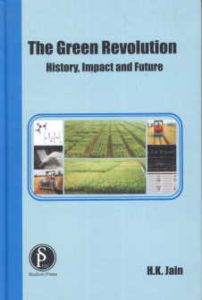
Contents: Foreword. Preface. 1. Origin and advance of traditional agriculture. 2. The Mendel's discoveries and scientific plant breeding. 3. The advent of inorganic fertilizers. 4. Pest and disease management. 5. Modern systems of irrigation. 6. New farm machines. 7. Transition to modern agriculture. 8. A breakthrough in wheat yields. 9. The rice revolution. 10. High-yielding varieties across countries and continents: the impact. 11. Agriculture of the future: new directions. Author index. Subject index.
“A brief history of the modernization of agriculture leading to the Green Revolution-A number of scientific discoveries and decisions by the policy makers had to come together for a breakthrough in the productivity of wheat and rice two of the important food staples of people in many parts of the world. The book in its 11chapters describes for the first time in a single publication these decisions, discoveries, new technologies, and their impact on food production, and examines the future direction of agriculture as it evolves in the 21 century. Once the science of the modern technology considered in five of the first six chapters was in place, traditional agriculture started to change in the early years of the 20 century. Chapter 7 marks this period of transition with reference to three major crop plants-maize, sugarcane and potato, which were to see some remarkable advances. Chapters 8 and 9 focus on the dwarf plant types of wheat and rice selected by farmers in Japan and Taiwan respectively. They became the source of genes for fertilizer responsive, high-yielding varieties of these crops at the two International Agricultural Research Centres – CIMMYT in Mexico and IRRI in the Philippines. It is these varieties and others developed subsequently by scientists in the national agricultural research institutions of many developing countries, which spearheaded the Green Revolution. The establishment of the two international centers by the leaders of the Rockefeller Foundation and the Ford Foundation marked a new paradigm of international collaboration in agricultural research. On their part, governments in many developing countries took unprecedented decisions to create a new institutional infrastructure of research and development to foster such collaboration, and to evolve high yielding varieties of their own, better adapted to the diverse agro-ecological conditions of their country and having grain quality characteristics preferred by their people. The impact of the high-yielding varieties on the production of wheat and rice in the developing countries is considered in chapter 10. The new technology came at a critical time when many of them were having serious problems of food shortage. But it has had its costs and there is a growing realization now among the scientists that the world would need a different kind of high yield technology in the years to come. It will have to be sustainable and safe for human health and for the environment. The last chapter considers some of the new concepts and directions of research which tee scientists are now pursuing.”